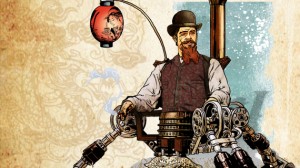The Empire and the Secession Wars
 We’ve gotten various comments (In email and on forum discussions) which indicate that there is still a bit of confusion regarding the setting of Far West. Some folks are still operating under the assumption that what we’re doing here is a historical fantasy, where the Wild West features more of a wuxia influence.
We’ve gotten various comments (In email and on forum discussions) which indicate that there is still a bit of confusion regarding the setting of Far West. Some folks are still operating under the assumption that what we’re doing here is a historical fantasy, where the Wild West features more of a wuxia influence.
This is not so. The world of Far West is a fantasy world — one that has no relation to our own. This isn’t historical fantasy, it’s just fantasy. The explanation that was given to playtesters was this: Middle-Earth was J.R.R. Tolkien creating a fantasy world inspired by the cultures and myths of the Anglo-Saxon, Finnish and Celtic peoples. The world of Far West is what would have resulted if his inspirations were instead Spaghetti Westerns, Wuxia, and steampunk.
What follows is a bit of historical tone-setting — a look into the world of Far West, and specifically the events that lead to the time and place we’re focusing on in the various projects that we’re doing:
—–
They say that the Empire has stood for a thousand years, and that might even be true. Who can say? Regardless, it sits, powerful and majestic, spread along the coast of the Eastern Ocean — port cities, filling with thronging multitudes, the seats of the great mercantile Chartered Houses, the centers of culture and art and industry and Imperial power.
Over the years, the Empire grew. The push West: more and more territory under the Imperial flag. Each of these territories had their own rulers, of course, to handle day-to-day affairs. A hundred Princes, Barons, Presidents, Mandarins and Ministers, all with their own petty thrones, yet all bending their knee to the Emperor — each designated as the Governor of an Imperial territory. Collectively, these outer territories, nearly but not quite independent, were referred to as the Periphery.
On occasion, an Imperial Governor would decide that his own title (King, Price, Baron, what have you) was his true calling, and the territory would rise up and declare itself truly independent of the Empire — a sovereign nation. Inevitably, the Empire would crush these rebellions underfoot, and install a new Governor — because no territory was ever lacking in an opposition group hungry for power.
And so it went, until The Secession Wars. It was then that one of the larger territories rebelled and broke away, and, as had happened so many times before, was brought under the focus of Imperial attention. Yet this time, several other territories saw this as their opportunity — while the Empire was busy putting down the rebellion in the first territory, it was reasoned that forces would be unable to respond quickly enough to others. A cascade of rebellions began, as more and more of the Periphery followed the lead of these first acts. Before long, the Empire was faced with nearly the entire Periphery in rebellion, with alliances forming between various break-away states for mutual defense and aid.
The Imperial forces had the power — industrial might; training; technology, etc. The Periphery had the numbers, however. There was simply too wide a front to effectively fight. Too many territories to occupy and pacify. Too much ground to cover.
Yes, it might have worked.
Might have, of course, if not for human nature, and specifically the nature of power to corrupt. For as easily as alliances are made, they are also broken. Treachery has its own rewards, after all. The Periphery was unable to maintain a unified defense against the Empire. Issues of self-interest trampled reason. Alliances crumbled as individual territories made opportunistic decisions, and old bad blood boiled over — arguments over resources and spoils of war.
The Empire moved methodically, taking its time. Concentrating its efforts on territories that had been isolated from others through their own actions, from the actions of their neighbors, or (in many cases) through the actions of Imperial spies who sowed mistrust throughout the Periphery. One by one, they crushed the rebelling territories, before turning their attentions to the next.
It was a long war, and hard-fought. The August Throne was in no hurry, however. The Secession Wars ended with the inevitability of a coming winter.
The new world was created. Peace and prosperity for all. For those who had lost everything in the war, there was no place for them. They headed West, to start new lives. For warriors, even those who had fought on the winning side, there was no place for them, either. Steeped in too much blood, and possessed of a skill and trade that was no longer desired, they also headed West.
Beyond the Periphery lies the Frontier. Settlements began to blossom. Yet even here the flower of civilization asked too much tending, and so men and women pushed further West.
Beyond the Frontier. Into the Far West.
“I look to the North,
the cold wind smells of pine and iron.
I look to the East,
the cool wind smells of jasmine and brine.
I look to the South,
the warm wind smells of citrus and loam.
I will not look to the West,
for the wind is full of dust,
and it smells of blood and glory.”
– Loora Vol, Poetess



AAAAGH. I want to play this so badly!